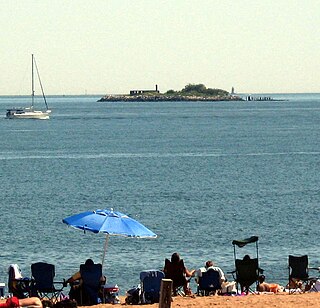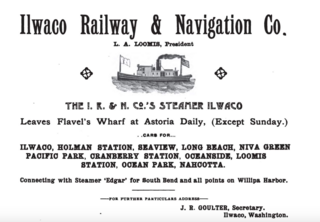
Astoria is a port city and the seat of Clatsop County, Oregon, United States. Founded in 1811, Astoria is the oldest city in the state and was the first permanent American settlement west of the Rocky Mountains. The county is the northwest corner of Oregon, and Astoria is located on the south shore of the Columbia River, where the river flows into the Pacific Ocean. The city is named for John Jacob Astor, an investor and entrepreneur from New York City, whose American Fur Company founded Fort Astoria at the site and established a monopoly in the fur trade in the early 19th century. Astoria was incorporated by the Oregon Legislative Assembly on October 20, 1856.

Swinburne Island is a 4-acre (1.6 ha) artificial island in Lower New York Bay, east of Staten Island in New York City. It was used for quarantine of immigrants. Swinburne Island is the smaller of two nearby islands, the other being Hoffman Island to the north.

The Columbia River Maritime Museum is a museum of maritime history in the northwest United States, located about ten miles (16 km) southeast of the mouth of the Columbia River in Astoria, Oregon.

The North Head Quarantine Station is a heritage-listed former quarantine station and associated buildings that is now a tourist attraction at North Head Scenic Drive, on the north side of Sydney Harbour at North Head, near Manly, in the Northern Beaches Council local government area of New South Wales, Australia. It is also known as North Head Quarantine Station & Reserve and Quarantine Station & Reserve. The property is owned by the Office of Environment and Heritage, an agency of the Government of New South Wales. The buildings and site were added to the New South Wales State Heritage Register on 2 April 1999. The entire 277-hectare (680-acre) North Head site, including the Quarantine Station and associated buildings and facilities, was added to the Australian National Heritage List on 12 May 2006, and now forms part of the Sydney Harbour National Park.

Grosse Isle is an island located in the St. Lawrence River in Quebec, Canada. It is one of the islands of the 21-island Isle-aux-Grues archipelago. It is part of the municipality of Saint-Antoine-de-l'Isle-aux-Grues, located in the Chaudière-Appalaches region of the province.
The Ilwaco Railway and Navigation Company operated a 3 ft narrow gauge railroad that ran for over forty years from the bar of the Columbia River up the Long Beach Peninsula to Nahcotta, Washington, on Willapa Bay. The line ran entirely in Pacific County, Washington, and had no connection to any outside rail line. The railroad had a number of nicknames, including the "Clamshell Railroad" and the "Irregular, Rambling and Never-Get-There Railroad."

The Philadelphia Lazaretto was the Second quarantine hospital in the United States, built in 1799, in Tinicum Township, Delaware County, Pennsylvania. The site was originally inhabited by the Lenni Lenape, and then the first Swedish settlers. Nearby Province Island was the site of the confinement of the Christian Moravian Indians who were brought there under protective custody from Lancaster, Pennsylvania, in 1763 when their lives were threatened by the Paxton Boys. The facility predates similar national landmarks such as Ellis Island Immigrant Hospital and Angel Island and is considered both the oldest surviving quarantine hospital and the last surviving example of its type in the U.S.

The MV Tourist No. 2 was a 1924 wooden-hulled car ferry that has served passengers all over the Pacific Northwest. Originally, it took passengers across the Columbia River, with a dock in Astoria, Oregon. It was undergoing restoration in Astoria until it sunk in 2022. It is listed on the National Register of Historic Places.

USCGC Elm (WLB-204) is a U.S. Coast Guard Juniper-class seagoing buoy tender home-ported in Astoria, Oregon. She is responsible for maintaining aids to navigation on the coasts of Oregon and Washington, including the Columbia River.

SS Iowa was a steamship built by the Western Pipe and Steel Company of San Francisco, California in 1920 for the U.S. government and was known as the SS West Cadron. It served in the Quaker Line subsidiary of the States Steamship Company. from 1928—when it was renamed the Iowa—until January 12, 1936, when it ran aground on Peacock Spit, Washington, part of the Columbia Bar at the mouth of the Columbia River.

Since the early 1980s, several non-steam-powered sternwheel riverboats have been built and operated on major waterways in the U.S. state of Oregon, primarily the Willamette and Columbia Rivers, as river cruise ships used for tourism. Although configured as sternwheelers, they are not paddle steamers, but rather are motor vessels that are only replicas of paddle steamers. They are powered instead by diesel engines. The Lurdine was, when launched in 1983, "the first passenger-carrying sternwheeler in decades to [operate] on the Columbia River". In the case of the 1983-built M.V. Columbia Gorge, the construction and operation of a tourist sternwheeler was led by local government officials who viewed the idea as potentially being a major tourist attraction, giving an economic boost to their area, Cascade Locks, Oregon.

Joseph George Megler, generally known as J.G. Megler, was a German-American salmon cannery owner and politician in Washington. He was a member of the Washington House of Representatives for the first legislature in 1889 and five terms thereafter. He was also a member of the Washington State Senate for two terms.

Coquille was a steamboat built in 1908 for service on the Coquille River and its tributaries. Coquille served as a passenger vessel from 1908 to 1916, when the boat was transferred to the lower Columbia River. Coquille was reconstructed into a log boom towing boat, and served in this capacity from 1916 to 1935 or later.

Sue H. Elmore was a steamboat built for service on the coast of Oregon and southwest Washington. From 1900 to 1917, the vessel's principal route ran from Portland, Oregon down the Columbia River to Astoria, and then west across the Columbia Bar, then south along the Oregon coast to Tillamook Bay. Once at Tillamook Bay, Sue H. Elmore was one of the few vessels that could reach Tillamook City at the extreme southern edge of the mostly very shallow bay. After this Sue H. Elmore was sold, being operated briefly in Puget Sound under the name Bergen, and then for many years, out of San Diego, California as a tugboat under the name Cuyamaca. During World War II Cuyamaca was acquired by the U.S. Army which operated the vessel as ST-361. Afterwards the army sold ST-361 and the vessel returned to civilian ownership, again under the name Cuyamaca. In 1948 Cuyamaca sank in a harbor in Venezuela, but was raised and by the early 1950s, was owned by one A. W. Smith, of Pensacola, Florida. This vessel's former landing place in Tillamook, Oregon is now a municipal park named after the ship.
W.H. Harrison was a steam schooner that operated from 1890 to 1905 on the coast of Oregon, the lower Columbia River, and southwest Washington state. At that time the salmon cannery industry was one of the major businesses of the coast. W.H. Harrison, while also carrying passengers and transporting general freight and lumber, was one of a number of steamers supplying materials to canneries along the coast, and transporting cases of canned salmon from the canneries.

Lytton Quarantine Station is a heritage-listed former quarantine station in Lytton, City of Brisbane, Queensland, Australia.

The Washington Avenue Immigration Station was an immigrant processing facility in Philadelphia, Pennsylvania, United States located at the end of Washington Avenue at Pier 53 on the Delaware River, south of modern-day Penn's Landing waterfront district. The building opened in 1873 and was demolished in 1915.

Ancon was an ocean-going wooden sidewheel steamship built in San Francisco in 1867. She carried both passengers and freight. In her early career she was a ferry in Panama and then ran between Panama and San Francisco. Later she began coastal runs between Sand Diego and San Francisco. Her last route was Port Townsend, Washington to Alaska. Today she is more notable for her disasters than her routine voyages. Ancon Rock in Icy Strait, Alaska is the site of her 1886 grounding. Her final wreck, in 1889 in Naha Bay, near Loring, Alaska was commemorated by Albert Bierstadt. His painting, "Wreck of the 'Ancon' in Loring Bay, Alaska" now hangs in the Museum of Fine Art in Boston.

Ilwaco was a small riverine and coastal steamship built in 1890 which was operated as a passenger vessel for the Ilwaco Railway and Navigation Company, and later served in other roles, including tow and freight boat, cannery tender and fish packing vessel. Ilwaco was originally named Suomi.

The Callendar Navigation Company, sometimes seen as the Callendar Transportation Company, started in business in the early 1900s. Callendar was formed in the early 1900s, and was based in Astoria, Oregon. Callender was to become one of six large towing companies of the Columbia and Willamette rivers in the early decades of the 1900s, the others being Shaver Transportation, Smith Transportation, Hosford, Knappton Towing Co., and Willamette and Columbia River Towing Co. In 1922, Callendar Navigation merged with Knappton Towboat Co., which existed, with a name change in 1990, and which became part of Foss Marine in 1993.





















